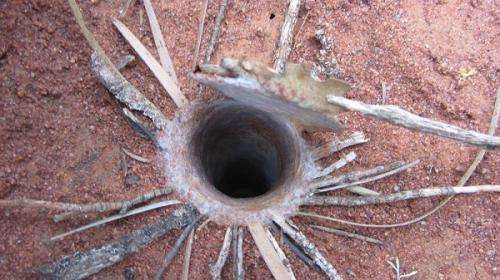Discovery: the trapdoor was carefully constructed with twigs and leaf litter radiating out from the rim of the burrow. They were unable to identify the species of spider living inside. Credit: Vanessa Westcott
A fauna-monitoring expedition at Eurardy Reserve, 145km north of Geraldton, has revealed the intricate life of trapdoor spiders.
Bush Heritage Australia and the Conservation Council of Western Australia were completing fauna surveys as part of managing the 30,000 hectare reserve, when they stumbled on a spider trapdoor.
"We were heading back from checking our monitoring sites when one of our volunteers spotted a beautiful trapdoor in York gum woodland," says Dr Vanessa Westcott a regional ecologist for Bush Heritage Australia.
"When we got down and had a look, we saw a cleverly camouflaged trapdoor covering a large hole the size of a 20 cent piece, which was carefully constructed with twigs and leaf litter radiating out from the rim of the burrow," Dr Westcott says.
"The twigs and leaf litter are used as trip lines so that unsuspecting insects walking in the vicinity of the burrow can be detected, grabbed and eaten."
Trapdoor spiders vulnerable
There are several trapdoor spider species that occur in the Mid West including the shield-backed trapdoor spider (Idiosoma nigrum) which is listed as 'vulnerable' under the Environment Protection and Biodiversity Conservation Act.
Female trapdoor spiders can live for up to 20 years. The female will stay within her burrow or in close proximity for her whole life, while males—which are smaller and more mobile—will venture off to find a mate.
"Shield-backed trapdoor spiders can have a burrow up to 30cm deep and as they grow inside the burrow they must widen it and add to the rim of the trapdoor to make sure it closes over the hole properly," Dr Westcott says.
"By having such a deep burrow they can keep the temperature and humidity at a constant level throughout the year."
Eurardy Reserve is located at the northern edge of the South West Botanical Province, a global biodiversity hotspot. The diversity of plant species found in this region outranks that of Australia's tropical rainforests.
The reserve protects more than 500 plant species, including at least five nationally endangered or vulnerable plants, and forms a critical habitat link between Kalbarri National Park and Toolonga Nature Reserve to the north.
Provided by Science Network WA























